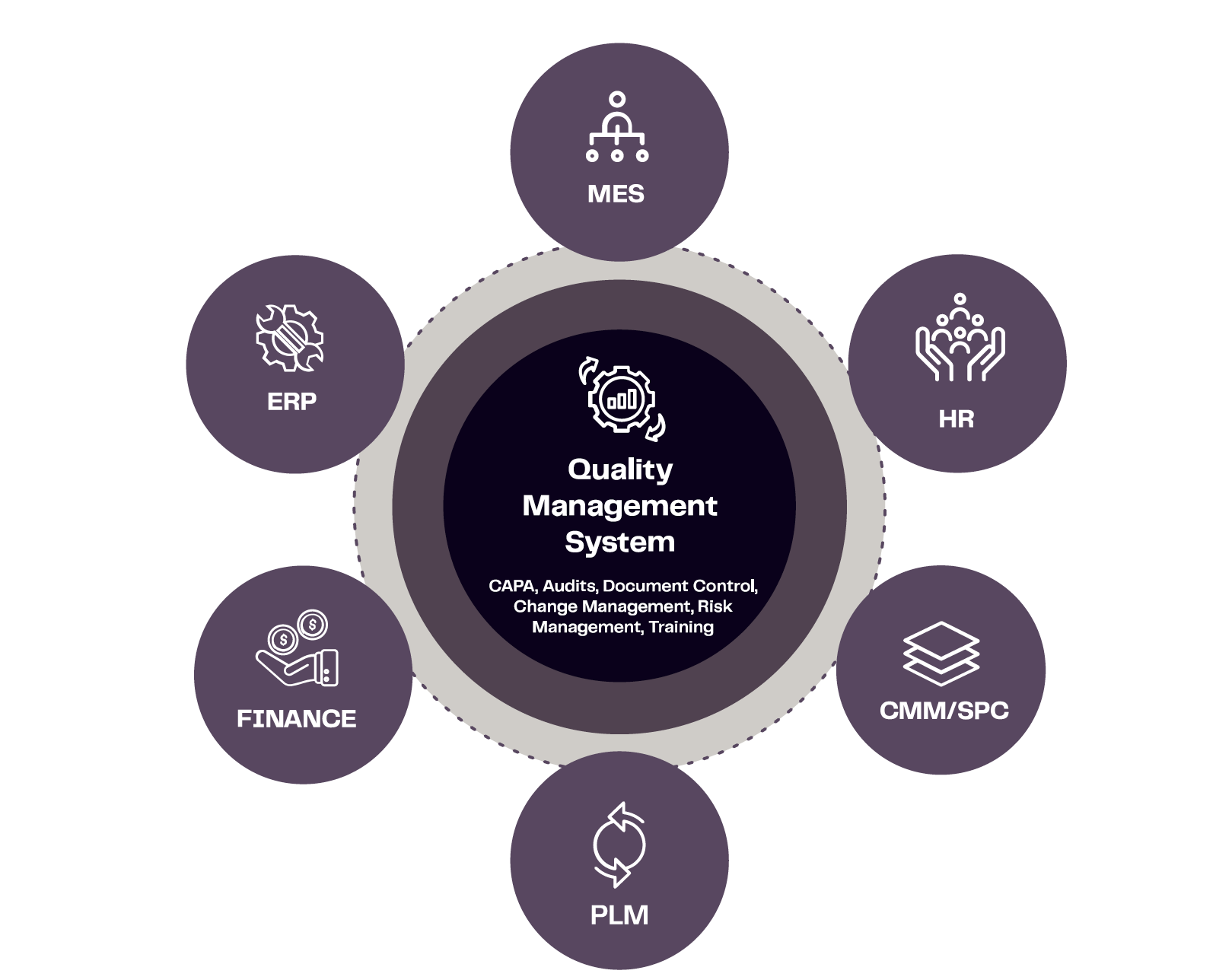Chapter three, of Advanced QMS for Dummies, looks at the importance of integrating your QMS software with other enterprise systems. Strategically connecting business systems can help put quality at the forefront of your organization’s culture using the technology that teams outside of Quality already use daily. For example, helpful automation and shared visibility of process performance can put your organization on the path to continuous quality improvement.
Connecting across the product lifecycle
So, how does a successful integration of your QMS software across enterprise systems look? As you start down the path, consider these critical criteria. Your QMS software needs to:
- Share and incorporate relevant data with enterprise-wide systems
- Solve quality problems and improve quality processes across the full product lifecycle
- Improve productivity and efficiency across the entire organization
The EQMS needs to share information with all the other systems in the enterprise. By doing so, it provides a single holistic solution for all quality management processes.
The figure below shows multiple apps that integrate with a QMS. Enterprise systems appear around the outside, with QMS as the hub. The hub provides a consolidated and standardized approach for your continuous improvement tools.

The QMS doesn’t just collect and centralize the information; it enhances it and transforms it into actionable intelligence. It provides the context that makes the information valuable.
Integrating the customer relationship management (CRM) system
A CRM system manages relationships with customers by track- ing and managing the information it has collected about them, such as addresses and purchase history. Integration with the CRM enables you to do such things as:
- Close the loop on customer feedback and complaints
- Alert staff to requests for new features or bring attention to product defects
- Synch updates with the CRM to communicate with the customer
Integrating the enterprise resource planning (ERP) system
An ERP enables organizations to integrate all their business processes, such as supply chain, financial, and manufacturing. Integrating the QMS with the ERP lets you do things like:
- Align QMS data with ERP data — the source of truth for data such as suppliers, customers, and products/materials
- Automatically update ERP when materials are put on hold or are released
- Enter data only once so quality management system users don’t have to copy and paste data or work from offline data sources (such as Excel exports from ERP)
- Enable QMS users to access up-to-date information without needing direct access to the ERP
- Handle return material authorization
- Manage credits associated with returned material
- Track waste and scrap
- React to non-conformances and automatically put products on hold in the ERP
Integrating the manufacturing execution system (MES)
An MES is used in manufacturing to monitor (in real-time) and follow raw goods as they’re turned into final products. Sharing the information between the QMS and the MES helps you to:
- Minimize the number of production systems employees need to interact with
- Report production problems and speed the time to resolution, reducing scrap and downtime (improving overall equipment effectiveness — OEE)
- Launch quality investigations
- Create more efficient product design and manufacturing lifecycles
- Deliver new product introductions more quickly
- Execute better response to market changes
Integrating the metrology solution
Quality control on a shop floor measures products on the line. Data gets aggregated within metrology software such as Statistical Process Control (SPC) to then feed a QMS, which enables:
- Identifying deviations, out of spec, and out of trend conditions
- Activating the QMS for further investigation, root cause analysis, and resolution
- Reducing repetitive data entry and errors in information in both the QC and QA systems
- Lowering costs for retooling and eliminating costly rework, often found in the “hidden factory” (the work needed down the line to fix defects)
- Communicating findings to appropriate teams, such as design and engineering for updated product specifications
Integrating product lifecycle management software (PLM)
A PLM is a system used to track and design a product from beginning to end. This includes design, production, and disposal. Sharing information between the QMS and the PLM provides the ability to:
- Continuously refine products based on manufacturing and customer feedback.
- Improve customer satisfaction and limit defects between product versions.
- Optimize change controls and improve communication and collaboration between teams.
- Enable users to add data from the production part approval process (PPAP) into the PLM workflow. This helps designers understand whether their existing suppliers can handle the new version of their product.
Benefiting from Integration with Other Enterprise Systems
Many benefits accrue to an organization that breaks down its silos to integrate its data from across the organization. Technical advances in the ability to collect and analyze data have made an. enormous difference for organizations that want to deliver what customers really want. Hear experts share examples.
Advantages of integrated systems
The benefits of an integrated system include being able to:
- Have a single source of truth for the entire organization
- React to quality events in a timely fashion
- Automate processes that span across multiple systems
- Eliminate manual data collection and analysis processes, thus reducing errors
- Access quality data in real-time to make quick decisions
- Have a 360-degree view of the entire organization
- Produce more valuable metrics within a broader organizational context
Cross-functional benefits
Taking a broader view, the integration of data supports the entire organization. Following are some specific examples of the ways data can provide benefits across departments:
- Marketing and sales: Marketing and sales can use the data to spread the word about quality and customer success.
- Customer service: Customer service can have near real-time access to quality data to connect support tickets
and provide the customer with detailed instructions for resolving the issue, which is a competitive advantage. - Purchasing: Vendors can be reviewed more thoroughly, and defective inventory can be spotted. Production managers can speed up inventory return, thereby saving money and avoiding product delivery delays.
- Finance: By improving the coordination of quality and account- ing, you can avoid getting billed for a flawed shipment.
- Corporate security: Cloud-based enterprise software enhances security by ensuring that you can rely on the cloud vendor to provide a layer of protection for your system.
- Human resources: Safety and health management is a crucial responsibility of the organization. Tracking employee incidents can identify needed workplace changes.
- Data integration enables you to analyze and identify job hazards before they happen. You can also break a job down into operational steps so that you can identify unsafe practices and make preventive recommendations.
- Supply chain management: Your communications with your suppliers are improved by a QMS. For example, detailing specific product quality advantages can bring added credibility to marketing collateral and help win more customers.
- Supplied part with a defect can automatically trigger an action in the QMS to flag the issue and begin a supplier corrective action process.
Integrating Your Supply Chain
There’s no question that supply chains continue to become more complex. In today’s competitive environment, your supply chain is likely to extend across continents and oceans, and your suppliers will have suppliers of their own. This fact should cause you to ask yourself how secure your supply chain is. As the saying goes, you’re only as strong as your weakest link. A single defect can bring your supply chain to a grinding halt and potentially dam- age your reputation — or, in some cases, taint an entire industry.
Hexagon’s Chief Operating Officer, Paolo Guglielmini, put it clearly during his keynote at the 2022 Hexagon Live event (33:52): “Quality is a shared promise. A powerful example is in the world of automotive. Fifteen to twenty years ago, 50 percent of the value chain was staying within the supply chain. As of today, that percentage is closer to 80 to 85 percent. Brands rely heavily on their suppliers to help them deliver on their quality promise.”
The pandemic spectacularly highlighted the precariousness of having a non-integrated supply chain. As a result, massive bottlenecks interrupted supply chains around the world. In fact, according to a 2020 IDG Research survey, 59 percent of IT decision-makers surveyed say that they’re accelerating their digital transformation efforts.
An integrated QMS that provides supplier management tools can lead to:
- Collaborating with suppliers, including adding data from production part approval process (PPAP), issue resolutions, and ratings
- Avoiding poor, unapproved substitute materials being used in production
- Qualifying a supplier’s ability to meet specification
- Instituting a shipping hold through the ERP until Engineering approves of new materials
- Issuing Nonconforming Material Reports (NCMRs) and Supplier Corrective Action Reports (SCARs) directly to suppliers
- Tracking supplier audits and results, recovering costs for poor products, and even disqualifying suppliers if they don’t improve
Make sure your suppliers are part of your quality management workflows at the appropriate level of security so you have a greater chance of catching defects early and more quickly address corrective actions.
Do you think that you’re seeing more recalls than ever before? You’re right. A recent study by the Public Interest Research Group (PIRG) showed that the ten most expensive food recalls have occurred in the past decade. Therefore, you need to be more focused on your supply chains than ever before.
Recognizing barriers to supply chain quality
Consider the issues of supplier quality that constrain organizations today. How many do you recognize as problems you face? They include:
Lack of visibility:
- Visibility is the cornerstone of supply chain quality. You need to be sure that you can spot problems as soon as possible.
- Inaccurate view of costs: To get a full view of how supplier quality impacts your costs, you need to go beyond material costs to include such things as inspection overhead and other non-material factors. Every mistake increases unit costs and reduces profitability.
- Lack of communication: Poor communication creates blind spots. You need to make sure you have an ongoing audit process to ensure that agreements are being followed.
- Outdated technology: Legacy systems that don’t seamlessly integrate with your current systems put your organization at
risk. All systems must work together to ensure that you can spot problems as early as possible. - Security concerns: Integration with suppliers can leave you and, by extension, your suppliers vulnerable. Using a QMS
helps to minimize the risk substantially. Connected supply chains require trust and cooperation among partners to maintain the integrity of the system. A solid QMS and supplier training goes a long way to ensure that you promote cybersecurity
Benefiting from supply chain integration
By integrating your supply chain with an advanced QMS, you solve the problems listed above. In addition, it allows you to make suppliers part of problem resolution. Learn how Wabtec masters supplier quality to reduce cost.
Prevent supplier quality issues before they occur. Include suppliers directly into your product lifecycle.
You accrue significant benefits from integrating your supply chain with your advanced QMS. These include:
- Control: You can integrate receiving and inspection to determine when particular materials need further inspection before being put into production.
- Collaboration: Suppliers understand the design specs and every stakeholder works together to identify and solve problems.
- Simplified benchmarking: Using updated supplier scorecards in your advanced QMS allows for simplified benchmarking.
- Early problem detection: You can evaluate components and subsystems received from suppliers, so any problems become apparent earlier in the process.
- A central system: Housing compliance certificates in a central system makes them easy to find and review.
- Centralized supplier corrective action request (SCAR) tracking: Faster resolution of problems is accomplished with centralized SCAR tracking.
- More effective management and enforcement of supplier quality agreements are possible when you have an integrated supply chain.
Each week we will share with you an excerpt of a chapter in the book. If you’d prefer to read in the book at your own pace please download here.
Each week we will share with you a chapter in the book. If you’d prefer to read the book at your own pace download here.


